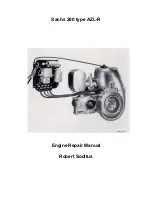
3.2
Section 3
Troubleshooting
Engine Loses Power
1. Low crankcase oil level.
2. High crankcase oil level.
3. Dirty air cleaner element.
4. Dirt or water in the fuel system.
5. Excessive engine load.
6. Engine overheated.
7. Faulty spark plug.
8. Low compression.
9. Exhaust restriction.
Engine Uses Excessive Amount of Oil
1. Incorrect oil viscosity/type.
2. Breather clogged or inoperative.
3. Worn or broken piston rings.
4. Worn cylinder bore.
5. Worn valve stems/valve guides.
6. Crankcase overfilled.
External Engine Inspection
Before cleaning or disassembling the engine, make a
thorough inspection of its external appearance and
condition. This inspection can give clues to what might
be found inside the engine (and the cause) when it is
disassembled.
Check for buildup of dirt and debris on the
crankcase, cooling fins, grass screen and other
external surfaces. Dirt or debris on these areas
can cause overheating.
Check for obvious oil leaks and damaged
components. Excessive oil leakage can indicate a
clogged or inoperative breather, worn or damaged
seals or gaskets, or loose fasteners.
Check the air cleaner cover and base for damage
or indications of improper fit and seal.
Check the air cleaner element. Look for holes,
tears, cracked or damaged sealing surfaces, or
other damage that could allow unfiltered air into
the engine. Also note if the element is dirty or
clogged. These could indicate improper
maintenance.
Check the carburetor throat for dirt. Dirt in the
throat is further indication that the air cleaner was
not functioning properly.
Check if the oil level is within the operating range
on the dipstick. If it is above, sniff for gasoline
odor.
Check the condition of the oil. Drain the oil into a
container; it should flow freely. Check for metal
chips and other foreign particles.
Sludge is a natural by-product of combustion; a small
accumulation is normal. Excessive sludge formation
could indicate the wrong type or weight of oil was
used, the oil was not changed at the recommended
intervals, an over-rich fuel mixture, or weak ignition, to
name a few possible causes.
NOTE: It is good practice to drain oil at a location
away from the workbench. Be sure to allow
ample time for complete drainage.
Cleaning the Engine
After inspecting the external condition of the engine,
clean the engine thoroughly before disassembling it.
Also clean individual components as the engine is
disassembled. Only clean parts can be accurately
inspected and gauged for wear or damage. There are
many commercially available cleaners that will quickly
remove grease, oil, and grime from engine parts.
When such a cleaner is used,
follow the
manufacturers instructions and safety precautions
carefully
.
Make sure all traces of the cleaner are removed
before the engine is reassembled and placed into
operation. Even small amounts of these cleaners can
quickly break down the lubricating properties of engine
oil.
Summary of Contents for Kohler SV470
Page 1: ...Workshop manual Kohler Courage Tractor Engines English ...
Page 3: ......
Page 17: ...1 14 Section 1 Safety and General Information ...
Page 43: ...5 16 Section 5 Fuel System and Governor ...
Page 93: ...9 14 Section 9 Inspection and Reconditioning ...
Page 116: ...2004W27 114 03 04 26 ...
















































